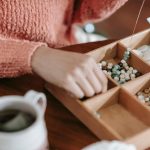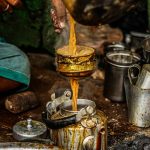When you think about creating unique patterns with tea staining, you might not realize the range of techniques at your disposal. Start by selecting a deep-colored tea and prepare your materials carefully, but that's just the beginning. Experimenting with layering, using sponges, or even applying stencils can yield surprising results. Each method opens up new avenues for texture and design, pushing your creativity further than you might expect. Curious about specific techniques that can elevate your projects? Let's explore those next.
Table of Contents
Key Takeaways
- Experiment with different tea concentrations to achieve varying depths and textures in your designs.
- Use natural sponges for sponging techniques to create mottled and organic effects.
- Incorporate resist methods like wax or stencils to produce intricate and contrasting patterns.
- Vary the pressure and amount of tea applied for diverse artistic outcomes.
Understanding Tea Staining
What makes tea staining a fascinating technique is its ability to create rich, organic patterns on various surfaces using simple ingredients. As you dive into this art form, you'll quickly discover its versatility. You can apply tea stains to paper, fabric, wood, and even ceramics, transforming everyday materials into unique pieces of art. The process is straightforward yet rewarding, allowing you to express your creativity without needing extensive supplies or skills.
The beauty of tea staining lies in its unpredictability. Each application yields different results, influenced by factors like the type of tea you choose, the surface you're working on, and the method you employ. This randomness encourages experimentation, inviting you to explore various techniques to achieve the desired aesthetic. You might find yourself layering stains or manipulating water to create gradients, enhancing the depth of your work.
Moreover, tea staining evokes a sense of nostalgia and warmth, reminiscent of aged documents and vintage textiles. This connection to history can infuse your projects with a unique character that elevates them beyond mere craft. Embrace the process, and let your imagination guide you as you create stunning, one-of-a-kind patterns.
Essential Supplies Needed
Gathering essential supplies is the first step to unleashing your creativity with tea staining.
Start with the most important item: tea. Any type will do, but black or green tea works best for rich, deep colors.
Next, choose your paper or fabric. Natural fibers like cotton, linen, or watercolor paper absorb the tea beautifully, producing stunning results.
You'll also need a container for brewing your tea. A bowl or pot will suffice, but make sure it's big enough to soak your materials.
Don't forget a strainer to remove tea leaves, ensuring a smooth application. A sponge, brush, or dropper can help you apply the tea precisely, allowing for intricate designs.
For added flair, consider using rubber bands, stencils, or even leaves to create patterns. These items will help you achieve unique textures and shapes.
Lastly, grab some protective gloves to keep your hands clean, and a flat surface covered with plastic or newspaper to catch spills.
With these supplies in hand, you're all set to explore the beautiful world of tea staining!
Prepare to create stunning, one-of-a-kind pieces that reflect your artistic vision.
Techniques for Unique Patterns
To create unique patterns with tea staining, you can experiment with various techniques like layering, sponging, and using resist methods.
Start by layering different tea concentrations. Use a stronger brew for bold areas and a lighter one for subtle details. Apply the stronger brew first, then follow up with lighter layers to build depth and texture.
Sponging is another excellent technique. Dip a natural sponge into your tea mixture and dab it onto the fabric or paper. This will give you a mottled effect, creating organic patterns that mimic nature. You can also vary the pressure and amount of tea on the sponge for more diverse results.
Resist methods can add even more creativity. Use wax, tape, or stencils to block certain areas from absorbing tea. Once the tea is applied, remove the resist materials to reveal the contrasting untouched sections. This technique allows you to create intricate designs and shapes.
Tips for Successful Staining
Experimenting with different techniques can lead to beautiful results, but a few tips can help ensure your tea staining process is successful.
First, always start with clean, dry fabric or paper. Any dirt or moisture can affect the stain's absorption, leading to uneven patterns.
Next, choose the right type of tea; black tea generally provides richer colors, while herbal teas can create softer tones.
When brewing your tea, let it steep longer for a darker shade. Once it's ready, test the color on a scrap piece before applying it to your main project. This lets you gauge how the final result will look.
To create unique patterns, consider using various applicators like brushes, sponges, or even your fingers. Each tool will produce distinct textures.
Don't forget to control the staining process; you can layer colors for depth or use water to dilute for lighter effects.
After staining, let your piece dry completely before handling it. Finally, consider setting your stain with a fixative to enhance longevity.
With these tips in mind, you're well on your way to creating stunning, one-of-a-kind tea-stained pieces!
Creative Project Ideas
You can transform everyday items into art pieces by incorporating tea staining into various creative projects. This technique not only adds depth and character but also allows you to explore your artistic side. Here are some exciting ideas to inspire your next tea staining adventure:
| Project Idea | Description |
|---|---|
| Stained Paper Art | Create unique greeting cards or wall art using stained paper. |
| Vintage Fabric Napkins | Tea stain plain napkins for a rustic dining experience. |
| Altered Books | Revamp old books by staining the pages for a worn look. |
| Stained Tote Bags | Give a new life to canvas bags with artistic tea stains. |
| Customized Gift Wrap | Use tea-stained paper to wrap gifts, adding a personal touch. |
Experiment with different types of tea and staining techniques to achieve various effects. You'll enjoy the unpredictability of the patterns created, making each project one-of-a-kind. So gather your materials, brew some tea, and let your creativity flow!
Frequently Asked Questions
Can I Use Herbal Teas for Staining, or Only Black Tea?
You can definitely use herbal teas for staining! They offer various colors and effects, just like black tea. Experiment with different types to see which ones create the unique shades you're aiming for in your project.
How Do I Remove Tea Stains From Unwanted Areas?
To remove tea stains from unwanted areas, quickly blot the stain with a clean cloth, then apply a mixture of water and mild detergent. Rinse thoroughly, and repeat if necessary until the stain disappears.
What Is the Best Paper Type for Tea Staining?
For tea staining, you'll want to use absorbent papers like watercolor or cardstock. These types soak up the tea well, allowing you to create rich, textured patterns that enhance your artistic projects beautifully.
How Long Does It Take for Tea Stains to Dry Completely?
Tea stains typically take about 30 minutes to an hour to dry completely, depending on the paper type and environmental conditions. Make sure to check for dryness before handling to avoid smudging.
Can I Seal My Tea-Stained Projects to Preserve Patterns?
Yes, you can seal your tea-stained projects! Use a spray sealant or clear acrylic finish to preserve those beautiful patterns. Just ensure the stains are completely dry before applying the sealant for best results.
- What Is Pochampally Ikat? a Journey to India’s Silk City - June 27, 2025
- What Is Pochampally Ikat? a Journey to India’s Silk City - June 27, 2025
- What Is Pochampally Ikat? a Journey to India’s Silk City - June 27, 2025






